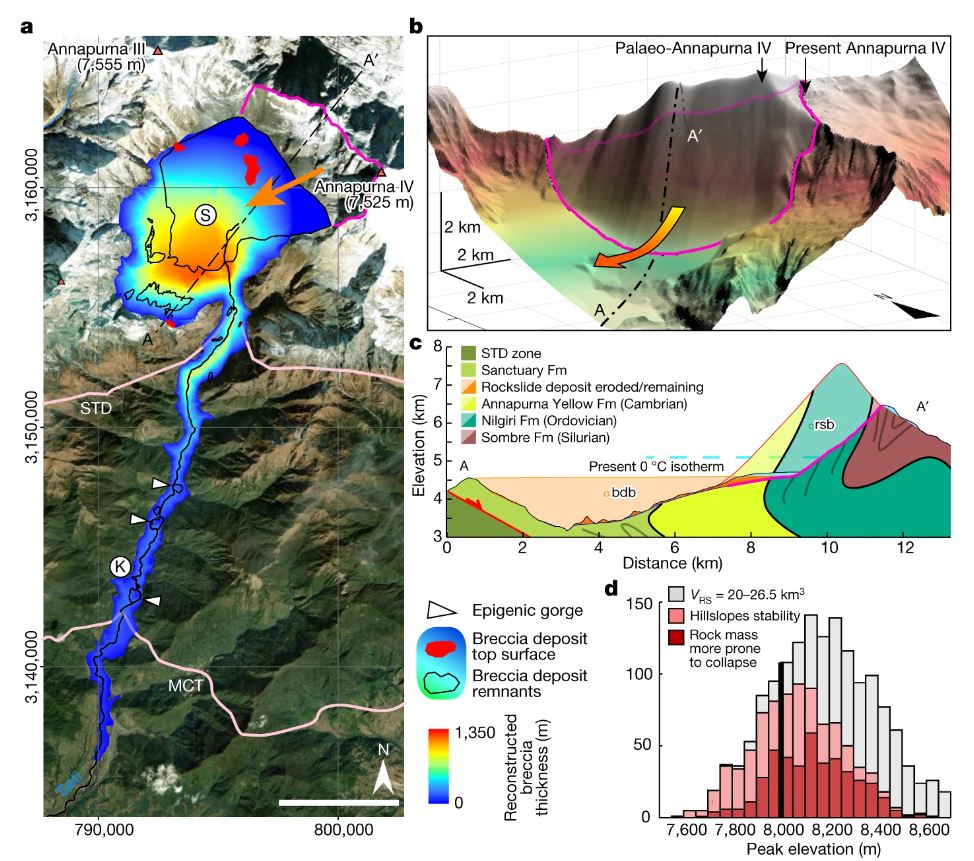14 July 2023
The Medieval 23 cubic kilometre Sabche rockslide in Annapurna, Nepal
Posted by Dave Petley
The Medieval 23 cubic kilometre Sabche rockslide in Annapurna, Nepal
A paper (Lavé et al. 2023) was published in the journal Nature last week that, perhaps surprisingly, garnered comparatively little attention. It describes an enormous landslide that occurred from the Annapurna mountain range in Nepal, effecively decaptitating one of the largest peaks. The authors estimate that the landslide had a volume of about 23 cubic kilometres.
That a very large mass movement occurred in the Annapurna area is not new. The city of Pokhara, the second largest in Nepal, is built on a series of enormous terraces that had previously been identified as being the aftermath of one or more catastrophic debris flows (see for example Fort 2010). These had been dated to about 500 years BP, but the origin of this landslide sequence was less clear.
Lavé et al. (2023) have examined the geology the area, concluding that the source was an enormous rock avalanche, which they are terming the Sabche rockslide, originating from the Annapurna Massif. They have dated this to about the year 1200. The Google Earth image below shows the source zone:-

Google Earth image of the source zone of the Sabche rockslide from the Annapurna massif in Nepal.
.
The sediments in the central part of this bowl are predominantly limestone brecchias, which are considered by the authors to be the remnants of the rock avalanche. Note also the much more recent deposit from the huge, but very much smaller, Seti Valley rock avalanche in May 2012, which a group of us pieced together on this blog.
The authors have attempted to reconstruct the original topography, and thus the approximate scale of the Sabche rockslide, in this diagram from the paper:-

A reconstruction of the Sabche rockslide from Nepal, from Lavé et al. (2023).
.
In the diagram to the left, the rear scarp of the landslide is outlined in purple, whilst the thickness of the brecchia is in the blue-red colour-scale. The extent of the runout of the landslide is shown. Lavé et al. (2023) postulate that in the century after the landslide, an enormous amount of sediment remobilisation occurred, moving the brecchia from its initial position downstream to create the enormous terraces in the Pokhara area. It is fascinating that this appears to have occurred very rapidly after the landslide – the mechanisms for this are unclear to me.
Finally, it is interesting to speculate on the trigger for the landslide. One possibility is an earthquake, but there is no recorded event in the Himalayas for this time. Thus, it is unlikely to have been a large seismic event, but one cannot discount a more localised, shallow crustal earthquake. Another possibility is climatic forcing – the Sabche rockslide occurred in the Medieval Climate Anomaly, when temperatures are thought to have been higher in the Himalayas. However, some megalandslides occur through progressive failure, requiring no external trigger. This may be the case here.
Overall, this is a fascinating paper that should spur further research into this landslide, and into the possibility of similar events elsewhere in the Himalayas. The great challenge now will be to undertake further work within the source zone of the Sabche rockslide – this is an area that is extremely difficult to access, so it will be quite an adventure.
.
References
Fort, M. 2010. The Pokhara Valley: A Product of a Natural Catastrophe. In: Migon, P., Geomorphological Landscapes of the World. Springer. pp 265-274.
Lavé, J., Guérin, C., Valla, P.G. et al. 2023. Medieval demise of a Himalayan giant summit induced by mega-landslide. Nature 619, 94–101 (2023). https://doi.org/10.1038/s41586-023-06040-5


 Dave Petley is the Vice-Chancellor of the University of Hull in the United Kingdom. His blog provides commentary and analysis of landslide events occurring worldwide, including the landslides themselves, latest research, and conferences and meetings.
Dave Petley is the Vice-Chancellor of the University of Hull in the United Kingdom. His blog provides commentary and analysis of landslide events occurring worldwide, including the landslides themselves, latest research, and conferences and meetings.
Hi Dave,
from my quiet place of retirement I send you a link of an extreme case of canyoning in one of the last blank spaces on our earth. Lave et al. have not been the only ones who have recently developed the idea of the giant mountain collapse in Annapurna massiv.
Unexplained remains in both groups of scientists how the Sabche Cirque was closed after galcier have carved out teh valley and had their way out towards Pokhara. Compare it with Modi River more to the west near Annapurna base camp (in Google Eatrh). I had given an explanation during my keynote 2026 during NGS congress: huge rock slide/creep from the eastern flank after retreat of glacierthus closing the cirque.
Cheers
Jörg
https://www3.nhk.or.jp/nhkworld/en/ondemand/video/4001432/